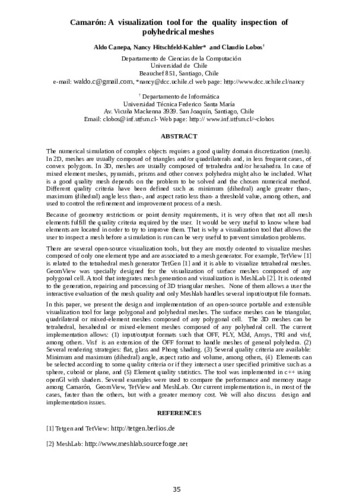Mostra el registre d'ítem simple
Camarón: a visualization tool for the quality inspection of polyhedrical meshes
| dc.contributor.author | Canepa, Aldo |
| dc.contributor.author | Hitschfeld-Kahler, Nancy |
| dc.contributor.author | Lobos, Claudio |
| dc.date.accessioned | 2020-12-01T15:44:19Z |
| dc.date.available | 2020-12-01T15:44:19Z |
| dc.date.issued | 2015 |
| dc.identifier.citation | Canepa, A.; Hitschfeld-Kahler, N.; Lobos, C. Camarón: a visualization tool for the quality inspection of polyhedrical meshes. A: ADMOS 2015. CIMNE, 2015, p. 35. |
| dc.identifier.uri | http://hdl.handle.net/2117/333682 |
| dc.description.abstract | The numerical simulation of complex objects requires a good quality domain discretization (mesh). In 2D, meshes are usually composed of triangles and/or quadrilaterals and, in less frequent cases, of convex polygons. In 3D, meshes are usually composed of tetrahedra and/or hexahedra. In case of mixed element meshes, pyramids, prisms and other convex polyhedra might also be included. What is a good quality mesh depends on the problem to be solved and the chosen numerical method. Different quality criteria have been defined such as minimum (dihedral) angle greater than-, maximum (dihedral) angle less than-, and aspect ratio less than- a threshold value, among others, and used to control the refinement and improvement process of a mesh. Because of geometry restrictions or point density requirements, it is very often that not all mesh elements fulfill the quality criteria required by the user. It would be very useful to know where bad elements are located in order to try to improve them. That is why a visualization tool that allows the user to inspect a mesh before a simulation is run can be very useful to prevent simulation problems. There are several open-source visualization tools, but they are mostly oriented to visualize meshes composed of only one element type and are associated to a mesh generator. For example, TetView [1] is related to the tetrahedral mesh generator TetGen [1] and it is able to visualize tetrahedral meshes. GeomView was specially designed for the visualization of surface meshes composed of any polygonal cell. A tool that integrates mesh generation and visualization is MeshLab [2]. It is oriented to the generation, repairing and processing of 3D triangular meshes. None of them allows a user the interactive evaluation of the mesh quality and only Meshlab handles several input/output file formats. In this paper, we present the design and implementation of an open-source portable and extensible visualization tool for large polygonal and polyhedral meshes. The surface meshes can be triangular, quadrilateral or mixed-element meshes composed of any polygonal cell. The 3D meshes can be tetrahedral, hexahedral or mixed-element meshes composed of any polyhedral cell. The current implementation allows: (1) input/output formats such that OFF, PLY, M3d, Ansys, TRI and visf, among others. Visf is an extension of the OFF format to handle meshes of general polyhedra. (2) Several rendering strategies: flat, glass and Phong shading. (3) Several quality criteria are available: Minimum and maximum (dihedral) angle, aspect ratio and volume, among others, (4) Elements can be selected according to some quality criteria or if they intersect a user specified primitive such as a sphere, cuboid or plane, and (5) Element quality statistics. The tool was implemented in c++ using openGl with shaders. Several examples were used to compare the performance and memory usage among Camarón, GeomView, TetView and MeshLab. Our current implementation is, in most of the cases, faster than the others, but with a greater memory cost. We will also discuss design and implementation issues. |
| dc.format.extent | 1 p. |
| dc.language.iso | eng |
| dc.publisher | CIMNE |
| dc.rights | Open access |
| dc.subject | Àrees temàtiques de la UPC::Matemàtiques i estadística::Anàlisi numèrica::Mètodes en elements finits |
| dc.subject.lcsh | Finite element method |
| dc.subject.lcsh | Digital computer simulation |
| dc.title | Camarón: a visualization tool for the quality inspection of polyhedrical meshes |
| dc.type | Conference report |
| dc.subject.lemac | Simulació per ordinador digital |
| dc.rights.access | Open Access |
| local.citation.contributor | ADMOS 2015 |
| local.citation.startingPage | 35 |
| local.citation.endingPage | 35 |


